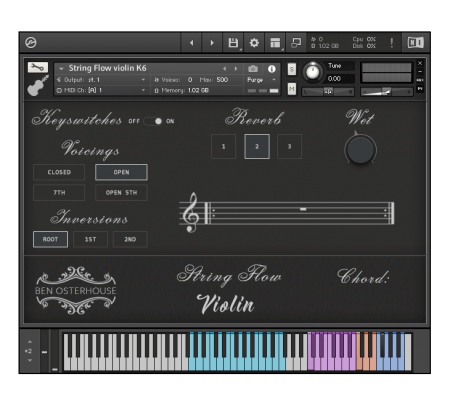Additional Libraries
Ben Osterhouse String Flow Violin v1.3.1 [KONTAKT]

Team DECiBEL | 11 August 2020 | 856.2 MB
String Flow Violin samples a technique string players use, in which they quickly roll the bow across the strings to create an energetic, chordal texture.
There are 2 ways to play the instrument.
The first way is simple: just choose what type of chord you want, what key to be in, and then play on the white keys. Whatever you play will pick a harmony which will fit into whatever key you've chosen. It's kind of like the "Harmonize" factory scripts in Kontakt, except that in this case, all of the harmonies had to be manually recorded!
The second way to play requires more knowledge of the instrument, and is more flexible. If you play a chord that has been recorded, the instrument will play that chord on violin The midi clips which come with the instrument demonstrate which chords work.
Works with the FULL version of Kontakt 5.8.1 and Kontakt 6
FEATURES
- The interface reacts to notes played, displaying what the music notation would look like to the player, and also showing which voicing, inversion, and key the chord is in. This could be an educational for those looking to write music for live musicians.
- Comes with a collection of midi clips to introduce the instrument. These include a collection of short progressions, and examples of all the possible voicings.
- Each chord was played for 4 measures (about 9 seconds). Loops are enabled for all samples.
- Automatically tempo-syncs to project tempo. The samples were recorded at 100BPM. 85 - 160BPM sounds good, and the optimal tempo is 120BPM.
- Chords are organized into 4 different types of voicings. Closed spacing, open spacing, 7th chords, and open 5ths.
- The closed spacing chords were recorded in both major and minor, and in all 3 inversions. The 7th chords include a dominant 7th, minor 7th, and major 7th voicing.
- Except for the open 5ths voicings, each chord recorded at 2 velocity layers, and each velocity layer has a normale version and a ponticello version, which can be crossfaded between using the modwheel. This is a good way to add motion to the sound.
- The louder velocity layer has rubato which adds contrast, and brings out the bassline.
Changelog V1.1
New Feature - Playing a key switch that changes either the inversion or the voicing of a chord, the chords change right away
Changelog V1.2
Sample improvements
Changelog V1.3
Minor bug fixes
home page
There are 2 ways to play the instrument.
The first way is simple: just choose what type of chord you want, what key to be in, and then play on the white keys. Whatever you play will pick a harmony which will fit into whatever key you've chosen. It's kind of like the "Harmonize" factory scripts in Kontakt, except that in this case, all of the harmonies had to be manually recorded!
The second way to play requires more knowledge of the instrument, and is more flexible. If you play a chord that has been recorded, the instrument will play that chord on violin The midi clips which come with the instrument demonstrate which chords work.
Works with the FULL version of Kontakt 5.8.1 and Kontakt 6
FEATURES
- The interface reacts to notes played, displaying what the music notation would look like to the player, and also showing which voicing, inversion, and key the chord is in. This could be an educational for those looking to write music for live musicians.
- Comes with a collection of midi clips to introduce the instrument. These include a collection of short progressions, and examples of all the possible voicings.
- Each chord was played for 4 measures (about 9 seconds). Loops are enabled for all samples.
- Automatically tempo-syncs to project tempo. The samples were recorded at 100BPM. 85 - 160BPM sounds good, and the optimal tempo is 120BPM.
- Chords are organized into 4 different types of voicings. Closed spacing, open spacing, 7th chords, and open 5ths.
- The closed spacing chords were recorded in both major and minor, and in all 3 inversions. The 7th chords include a dominant 7th, minor 7th, and major 7th voicing.
- Except for the open 5ths voicings, each chord recorded at 2 velocity layers, and each velocity layer has a normale version and a ponticello version, which can be crossfaded between using the modwheel. This is a good way to add motion to the sound.
- The louder velocity layer has rubato which adds contrast, and brings out the bassline.
Changelog V1.1
New Feature - Playing a key switch that changes either the inversion or the voicing of a chord, the chords change right away
Changelog V1.2
Sample improvements
Changelog V1.3
Minor bug fixes
home page
Only registered users can see Download Links. Please or login.


No comments yet